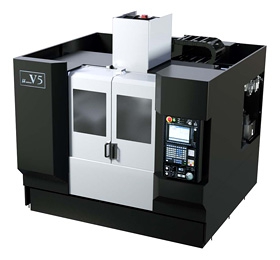
Mitsubishi Heavy Industries Machine Tool Co. Ltd. has developed the "µV5" (micro V5) micro milling machine, the latest in its µV (micro V) series. The µV5 has a bigger working surface table and wider process stroke than the current µV1, allowing for high-efficiency machining with micrometer-level (1/1,000 mm) precision for large products or those that require fine milling using small diameter tools, such as molds for car optical components. The µV5 meets demand for a wide range of applications such as precision automotive parts, large-scale molds for display casings and other products, separators (the main component of fuel cells), and shaping blades for rotating machines.
The µV5 continues the high standards of precision established by the µV1, developed and launched in 2006 for machining of precise dies and molds, electrodes, and precision parts. The newly developed 30,000 RPM high-performance spindle incorporates a special jet lubricating system that circulates lubricating oil warmed to match the frame temperature to the internal part and outer casing of the spindles. The machine has a high rigidity symmetrical frame, with an optimal structure for heat resistance and machine rigidity, while providing high attenuation with slide guideways for each axis, offering the best machined surface quality for a wide variety of materials. Thorough cooling of each heat source also minimizes thermal displacement, allowing for stable operation over long periods.
The primary spindle used in the µV5 is a high-speed, high-performance wide range spindle, which also ensures high precision with little thermal displacement. Further, Mitsubishi Heavy Industries Machine Tool's proprietary Optical Image-type Tool Measurement System can accurately measure the position of the rotating tool end using a high resolution CCD (charge coupled device) camera, allowing for tracked precision machining even for cuts with micrometer-level accuracy. The working surface of the table is 1,050×550 mm, and can accommodate large workpieces of up to 800 kg.
The µV series lineup includes the three-axis µV1, and the five-axis µV1-5X machine with a tabletop inclined spindle and rotating spindle, expanding the range of applications to include cutting of non-ferrous materials, and producing various types of small tools. The lineup is highly regarded for low downtime and minimal deterioration in precision over time, as well as the proprietary Optical Image-type tool measurement system. The introduction of the µV5 allows for precision machining of larger products.
Contact Details
Related Glossary Terms
- gang cutting ( milling)
gang cutting ( milling)
Machining with several cutters mounted on a single arbor, generally for simultaneous cutting.
- milling
milling
Machining operation in which metal or other material is removed by applying power to a rotating cutter. In vertical milling, the cutting tool is mounted vertically on the spindle. In horizontal milling, the cutting tool is mounted horizontally, either directly on the spindle or on an arbor. Horizontal milling is further broken down into conventional milling, where the cutter rotates opposite the direction of feed, or “up” into the workpiece; and climb milling, where the cutter rotates in the direction of feed, or “down” into the workpiece. Milling operations include plane or surface milling, endmilling, facemilling, angle milling, form milling and profiling.
- milling machine ( mill)
milling machine ( mill)
Runs endmills and arbor-mounted milling cutters. Features include a head with a spindle that drives the cutters; a column, knee and table that provide motion in the three Cartesian axes; and a base that supports the components and houses the cutting-fluid pump and reservoir. The work is mounted on the table and fed into the rotating cutter or endmill to accomplish the milling steps; vertical milling machines also feed endmills into the work by means of a spindle-mounted quill. Models range from small manual machines to big bed-type and duplex mills. All take one of three basic forms: vertical, horizontal or convertible horizontal/vertical. Vertical machines may be knee-type (the table is mounted on a knee that can be elevated) or bed-type (the table is securely supported and only moves horizontally). In general, horizontal machines are bigger and more powerful, while vertical machines are lighter but more versatile and easier to set up and operate.
- precision machining ( precision measurement)
precision machining ( precision measurement)
Machining and measuring to exacting standards. Four basic considerations are: dimensions, or geometrical characteristics such as lengths, angles and diameters of which the sizes are numerically specified; limits, or the maximum and minimum sizes permissible for a specified dimension; tolerances, or the total permissible variations in size; and allowances, or the prescribed differences in dimensions between mating parts.
- shaping
shaping
Using a shaper primarily to produce flat surfaces in horizontal, vertical or angular planes. It can also include the machining of curved surfaces, helixes, serrations and special work involving odd and irregular shapes. Often used for prototype or short-run manufacturing to eliminate the need for expensive special tooling or processes.






